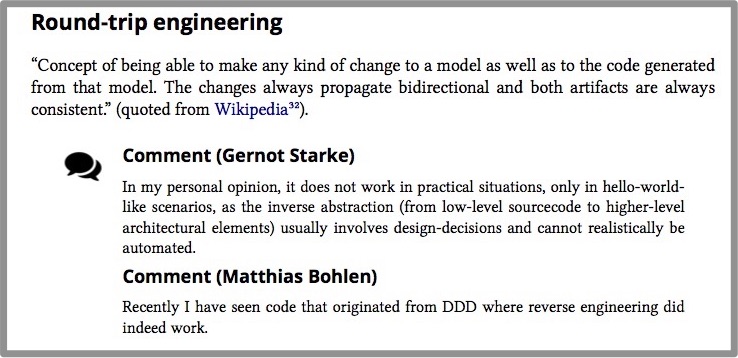A comprehensive glossary of software architecture terminology, many of them used in the iSAQB foundation and advanced level curricula.
This repository contains the sources for the published version of the iSAQB glossary, available both online and in various eBook formats at Leanpub (https://leanpub.com/isaqbglossary).
We also keep our reference translations, currently between English <-> German, these are generated from a JSON document into the markdown book source.
This book is made possible by collaborative effort of several iSAQB e.V. members. It's intended to support the non-profit interests of the iSAQB and the software architecture community in general.
We welcome suggestions and critique of any kind: Just open an issue here on Github!
Preview and production builds have to be triggered via the Leanpub website, as somehow the webhooks didn't seem to work (suggestions welcome).
The tables are generated by a small Groovy script from a JSON file. Its format is a simple list
with map entries, in file translations/isaqb-terms-translated.json.
[
{ en: "Appropriateness",
de: "Angemessenheit"
},
{ en: "Architectural View",
de: ["Architektursicht", "Sicht"]
}
// many more words...
]
If a single (English) term has multiple translations,
as in line 6 (de: ["Architektursicht", "Sicht"]), use a JSON list.
This file is parsed, lightly validated for syntax errors and then converted to Leanpub-flavored Markdown, one table per language, currently German ("de") and English ("en").
You can build the translation tables by calling ./gradlew generateTables (on unix or osx) or .\gradlew.bat generateTables from the command line.
The translator generates one markdown file for every language - currently
you need to manually copy those into the manuscript/generated-dont-edit
directory.
The translation tables currently only support two languages, EN and DE.
- English is the master language, code "en".
- Every entry needs to have an English term.
- Every entry must have at least a single translation to another language,e.g. from en to de.
- A term might have a list of translations in other languages (e.g. en:Tradeoff translates to de:[Kompromiss, Abwägung]
Each term can be described in multiple languages, denoted by the {lang=[language-code]} in their respective files (manuscript/terms).
You can build the markdown file of all terms that contain a translation to a specific language by calling ./gradlew generateTerms --args="<language-code>" (on unix or osx) or .\gradlew.bat generateTerms --args="<language-code>", where <language-code> stands for the desired language output.
Example:
./gradlew generateTerms --args="de"
The translator generates one markdown file - generated/gen-terms-<language-code>.md.
Currently you need to manually copy this into the manuscript/generated-dont-edit directory.
As this book combines the efforts of several authors, some personal opinions or comments might be added, to give a broader perspective on some definitions.
If you want to add your opinion or comment to any term in the glossary, please use the "discussion sidebar" syntax like shown below:
D> ###### Comment (Gernot Starke)
D> In my personal opinion, it does not work in practical situations, only in hello-world-like scenarios, as the inverse abstraction (from low-level sourcecode to higher-level architectural elements) usually involves design-decisions and cannot realistically be automated.
D>
D> ###### Comment (Matthias Bohlen)
D>Recently I have seen code that originated from DDD where reverse engineering did indeed work.
This will yield the following output (captured from the pdf version, will look different in web or epub versions):
The initial version of this glossary has been contributed by Gernot Starke. Prior versions of the (German) iSAQB glossary had been compiled and edited by Dr. Ulrich Becker, Wolfgang Fahl, Phillip Ghadir, Dr. Peter Hruschka, Dr. Carola Lilienthal, Martin Roesch and others.
Currently the content is maintained by volunteers from the iSAQB e.V., a non-profit volunteer association - see the contributors list of this repository.
You can become contributor (and will be added to the Leanpub contributor page) if you:
- Fix 3 or more issues from the Github issue list
- Open 5 significant issues (typos, spelling mistakes, simple formating issues and other trivial stuff does not qualify as significanct).
- Provide significant input by mail or other means to existing authors. Statements of the form "xy should be done, but I won't do it.." without further contributions do not qualify as significant.
You will be promoted to the Leanpub author list of the book if you either:
- Provide 3 or more new definitions of terms that will be accepted by the existing authors.
- Substantially enhance 5 or more definitions that will be accepted by the existing authors. Examples: Include diagrams to illustrate patterns or concepts.
- Substantially enhance other aspects of the glossary that will be accepted by the existing authors.
- Crosscheck one (complete) CPSA-Advanced Level module for terms missing in the glossary. (You need a (free) Leanpub account to become an author.)
All royalties from Leanpub sales of this book are donated to the Electronic Frontier Foundation (eff.org).
This book is licensed under a Creative Commons Attribution 4.0 International License.
The following is only a brief summary and no substitution for the real licence.
The cc-4.0-by license means that you might:
- Share — copy and redistribute the material in any medium or format
- Adapt — remix, transform, and build upon the material for any purpose, even commercially.
- The licensor cannot revoke these freedoms as long as you follow the license terms.
You must:
- Give appropriate credit,
- Provide a link to the license (https://creativecommons.org/licenses/by/4.0/), and
- Indicate if changes were made.



